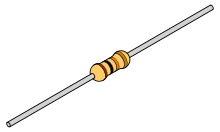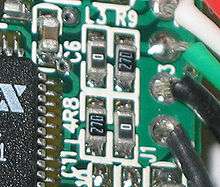Practical Electronics/Finding component information/Resistors
< Practical Electronics < Finding component information
Resistor colour code
Resistors are lablelled to allow you to see what their nominal value is. A "standard" through-hole mounted resistor has coloured bands painted onto it. These bands denote the value. Depending on the tolerance of the resistor, these my be 4, 5, or 6 bands on a resistor.
| Colour | Significant figures |
Multiplier | Tolerance | Temp. Coefficient (ppm/K) | ||
|---|---|---|---|---|---|---|
| Black | – | ×100 | – | 250 | U | |
| Brown | 1 | ×101 | ±1% | F | 100 | S |
| Red | 2 | ×102 | ±2% | G | 50 | R |
| Orange | 3 | ×103 | – | 15 | P | |
| Yellow | 4 | ×104 | – | 25 | Q | |
| Green | 5 | ×105 | ±0.5% | D | 20 | Z |
| Blue | 6 | ×106 | ±0.25% | C | 10 | Z |
| Violet | 7 | ×107 | ±0.1% | B | 5 | M |
| Gray | 8 | ×108 | ±0.05% | A | 1 | K |
| White | 9 | ×109 | – | – | ||
| Gold | – | ×10-1 | ±5% | J | – | |
| Silver | – | ×10-2 | ±10% | K | – | |
| None | – | – | ±20% | M | – | |
| ||||||
There are some menonics to remember the sequence of color code in the above table. A few of them are as follows:
- Bad Boys Race Our Young Girls, But Violet Generally Wins.
- Better Be Ready, Or Your Great Big Venture Goes West.
- B. B. ROY of Great Britain has a Very Good Wife.
Number codes

Surface mount resistors are too small for coloured bands to be easily read, but they have a flat surface instead, so the value is usually marked un the top surface of the device. This code is much the same as the colour code above, but explicitly written.
So, the code is written as two or three (depending on the tolerance of the device) numbers, followed by a multiplier digit, giving a three- or four-digit designation.
For example:
- A 1kΩ resistor can be marked 102 or 1001.
- A 470kΩ resistor can be marked 474 or 4703.
When the resistance is less than 100Ω, you must be careful, as the number may be mistakenly read as explicit. (We will deal with only 3-digit codes now):
- A 100Ω resistor can be marked 101 (i.e. 1, 0, followed by one zero)
- A 47Ω resistor is then marked 470 (i.e. 4, 7, followed by no zeros), or, to reduce chance of error, just 47 (there is no multiplier)
When the resistance is less than 10Ω, a capital "R" is used as a decimal point:
- An 8.2Ω resistor is marked 8R2
- A 0.1Ω resistor is marked 0R1
"Jumper resistors" have no resistance and are used to bypass tracks on a PCB. These are usually labelled 000 or just 0 .